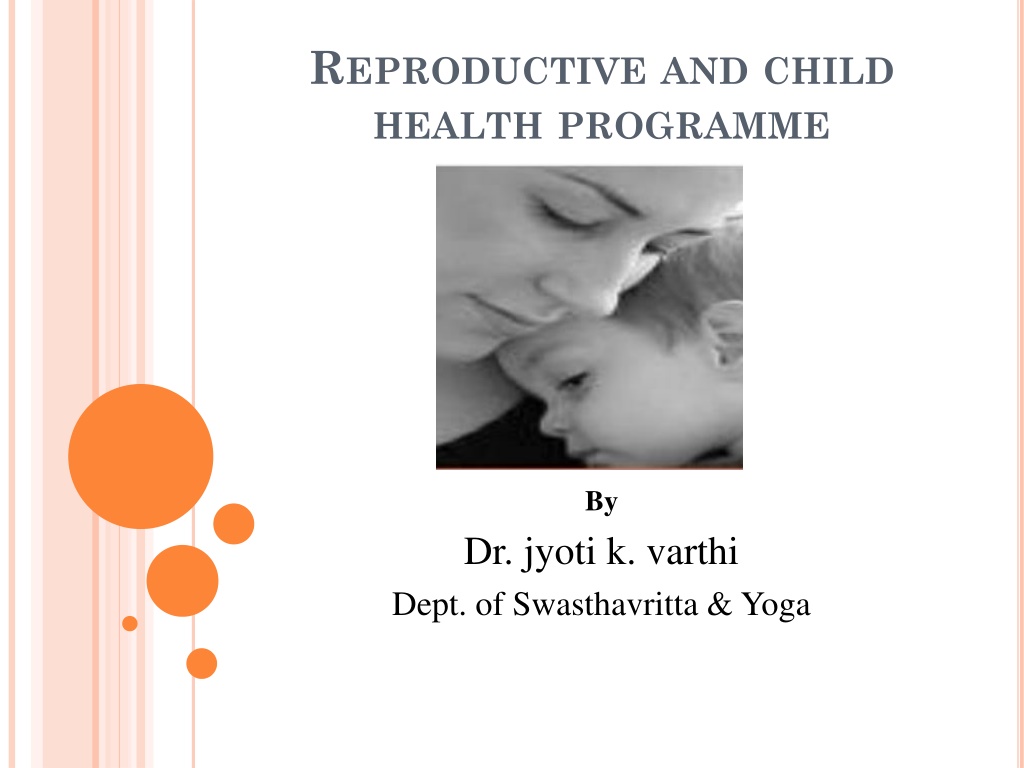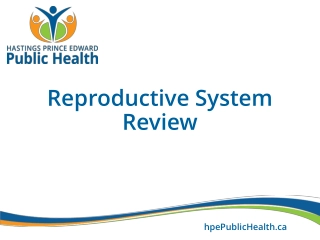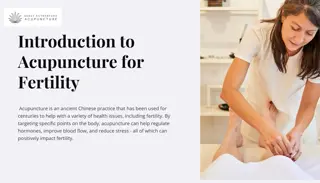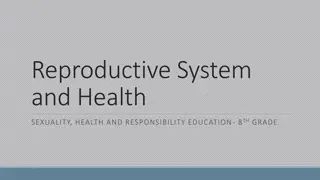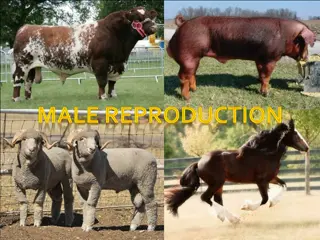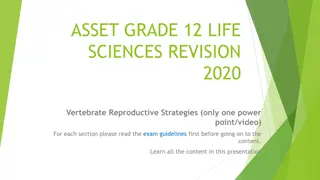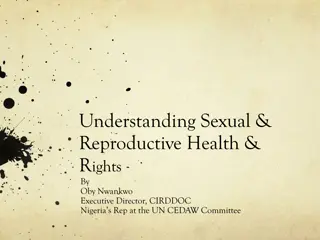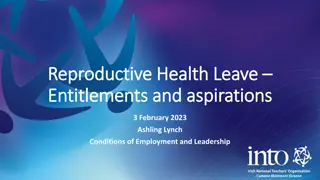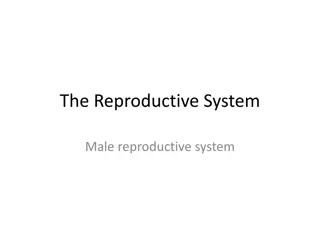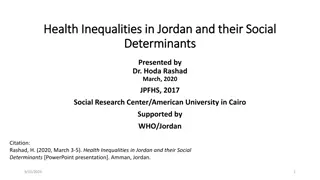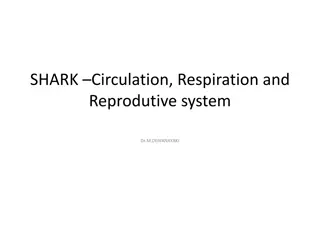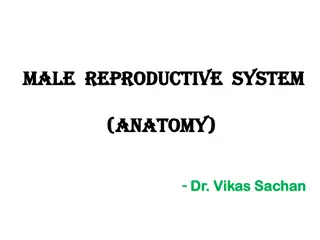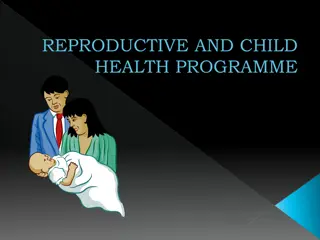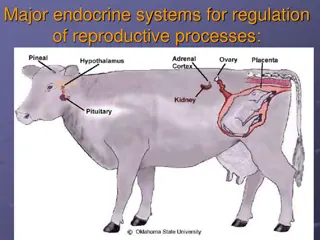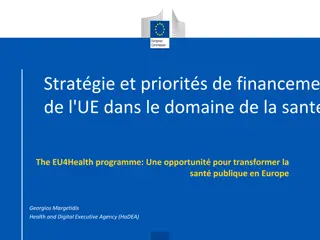Reproductive and Child Health Programme Overview
Dr. Jyoti K. Varthi from the Department of Swasthavritta & Yoga highlights the importance of the Reproductive and Child Health Programme. This program aims to ensure safe reproduction, regulate fertility, support maternal and infant health, and promote healthy sexual relationships. The initiative addresses the significant population of mothers and children in developing countries, including India, where maternal and infant mortality rates remain high. Various phases of the program have been launched since 1997, focusing on training, maternal care schemes, and an integrated approach to enhancing the health status of women and children. Components include prevention and management of reproductive health issues, family planning, and child survival efforts.
Uploaded on Oct 04, 2024 | 0 Views
Download Presentation

Please find below an Image/Link to download the presentation.
The content on the website is provided AS IS for your information and personal use only. It may not be sold, licensed, or shared on other websites without obtaining consent from the author. Download presentation by click this link. If you encounter any issues during the download, it is possible that the publisher has removed the file from their server.
E N D
Presentation Transcript
REPRODUCTIVE AND CHILD HEALTH PROGRAMME By Dr. jyoti k. varthi Dept. of Swasthavritta & Yoga
DEFINITION - People have the ability to reproduce and regulate their fertility, women are able to go through pregnancy and child birth safely, the outcome of pregnancies is successful in terms of maternal and infant survival and well being and couples are able to have sexual relations free of fear of pregnancy and of contacting diseases.
WHY THERE IS A NEED ? Mother and children comprise 71.14 % of the population of developing countries. 57.5 % of the population in India. Globally MMR ( Maternal mortality Ratio) averages 16/lac.live births in developed countries IMR and MMR are high in developing countries.
. RCH Phase 1 launched on 15thOctober, 1997. 2001-2002 A scheme for training of dais was initiated and implemented in 156 districts in 18 states/Uts. RCH Phase 2 launched on 1stApril 2005. JANANI SURAKSHA YOJANA (JSY) launched on 12thApril 2005. 1stJune 2011 govt. of India launched Janani shishu suraksha karyakram.( JSSK).
INTEGRATED APPROACH TO THE PROGRAMME Improving the health status of young women and children Namely- Family welfare programme. Universal immunization programme. Oral rehydration therapy. Child survival and safe motherhood. Acute respiratory infection control.
RCHPHASE-1 The program was formally launched on 15 October 1997. The RCH program National Family Welfare Program and Child Survival and & Safe Motherhood Program ( CSSM) Sexually transmitted disease and Reproductive tract infections. 7
COMPONENTSOF RCH PHASE- 1 PREVENTION/ MANAGEMENTOF RTI/STD/AIDS FAMILY PLANNING 8 CLIENT APPROACH TO HEALTH CARE CHILD SURVIVAL AND SAFE MOTHERHOOD
MAINHIGHLIGHTSOFRCHPROGRAM Safe Child Survival RTI/STD Family Planning MTP & IUD Insertion Private sector inclusion Collaborate with NACO in condom distribution Motherhood Specialist facilities for STD & RTI. Quality ANC Intensify existing services. Immunization, Institutional Deliveries CLIENT ORIENTED Address quality Based on needs of community NBC Skilled Birth Attendance Micronutrient Supply Emergency Obstetric care Chronic dirrohoel diseases Home based post- partum & NBC ARI Quality safe abortion services
MAJORINTERVENTIONUNDER RCH PHASE1 Essential obstetric care Emergency obstetric care 24 hour delivery service at PHCs / CHCs Medical termination of pregnancy Control of RTI & STD Immunization IEC Activities Essential new born care Diarrhoeal disease control 10. Acute respiratory disease control 11. Prevention & control of Vit A deficiency in children. 12. Prevention & control of anemia in children. 13. Introduction of Hepatitis B vaccination. 14. Training of Dais. 1. 2. 3. 4. 5. 6. 7. 8. 9.
INTERVENTIONINSELECTEDSTATES & DISTRICT Screening & treatment of RTI / STD Emergency obstetric care Essential obstetric care Additional ANM at sub centers. Improved delivery service & emergency care. Facility of referral transport of pregnant women
RCH PROGRAM: PHASE II RCH Phase II began from 1 April 2005. The components being: 1. Essential obstetric care 2. Emergency obstetric care 3. Strengthening referral system 14
NEWINITIATIVES Training Of PHC Doctors In Life Saving Anesthetic Skills For Emergency Obstetric Care At FRUS Setting Up Of Blood Storage Centers At FRUS Janani Suraksha Yojana Vandemataram Scheme Safe Abortion Services Village Health And Nutrition Day Maternal Death Review. Pregnancy Tracking Janani Shishu Suraksha Karyakram (JSSK) 15
A. ESSENTIALOBSTETRICCARE Promotion of institutional deliveries 50% of the PHCs and CHCs made operational as 24 hours delivery centers. Skilled attendance at birth. Policy decisions to permit Health workers to use drugs in emergency situations to reduce maternal mortality. 16
B. Emergency Obstetric Care :- Minimum services provided by FRU are 24 hour delivery services including normal and assisted deliveries. Emergency obstetric care including surgical interventions. New born care. Emergency care of sick children. Full range of family planning services including laproscopic services. Safe abortion services. Treatment of STD/RTI. Blood storage facility. Essential laboratory services. 10) Referral services. 1) 2) 3) 4) 5) 6) 7) 8) 9)
3 Critical determinants of a facility declared as a FRU Availability of surgical interventions New born care Blood storage facility a. b. c. C. Strengthening Referral system Indicates to involve local self help groups, NGOs and women groups.
24 HRS. FUNCTIONINGOF PHCS It is planned to establish 2000 FRUs in phases in RCH-II 50% PHCs and all CHCs to be operationalised in phases Availability of Services such as - 24 Hrs. Delivery services - New Born care - Family Planning, Counselling and services - Availability of RTI, STI services - Safe abortion services (MVA etc.) 19
TRAININGIN ANAESTHESIA Training of MBBS Doctors in Life Saving Anaesthetic Skills for Emergency Obstetric Care. 16 weeks training course The First Training Programme Conducted at AIIMS for Chhattisgarh 20
TRAININGIN OBSTETRIC MANAGEMENT Training of MBBS doctors in obstetric Management and skills including C.S. in RCH-II Training to be conducted in collaboration with FOGSI Duration of training to be 16 weeks. Expert Group is considering other details. 21
DRUGANDEQUIPMENTKITS: MID-WIFERY KIT & DRUGKIT Kit-E Laparotomy set Kit-F - Mini Laparotomy set Kit-G IUD insertion set Kit-H Vasectomy set Kit- I Normal delivery set Kit- J Vacuum extraction set Kit- k Embryotomy set Kit- L Uterine evacuation set Kit-M Equipment for anesthesia Kit-N- Neonatal resuscitation set Kit-O- Equipment and reagent for blood test Kit-P Donor blood transfusion set 23
BLOOD STORAGE FACILITY Management of obstetric emergencies is sometimes not possible due to non-availability of blood. The Drugs and Cosmetics Act was therefore modified to facilitate establishment of blood storage centers at FRU s. 24
JANANI SURKASHA YOJNA Launched on 12th April 2005 To promote Institutional Deliveries To reduce Maternal Mortality Ratio Infant Mortality Rate A safe motherhood intervention, replacing the National Maternity Benefit Scheme , under NRHM 100 % centrally sponsored Integrates cash assistance with delivery & post-delivery care. 25
VANDEMATRAM SCHEME It is a voluntary scheme wherein any obstetric and gynaec specialist, maternity home can volunteer Enrolled doctors will display Vandemataram logo at their clinics. Iron and folic acid tablets, oral pills, TT injections, etc will be provided for free distribution. 26
SAFE ABORTION PRACTICES MEDICAL METHOD Termination of early pregnancy (49days) using 2 drugs - mifeprestone followed by mesoprostol MANUAL VACCUM ASPIRATION Safe and simple technique for termination of pregnancy. Can be used at PHC or comparable facility 27
Village health & nutrition day- Once in a month at Anganwadi centres. Maternal death review Maternal death audit both facility and community based. Pregnancy tracking.
JANANISHISHUSURAKSHAKARYAKRAM Launched on 1st June 2011. Provide the new facilities to the pregnant women- Absolutely free and no expense delivery including caesarean section. Free medicine, diets, blood and transport. Similar entitlements for all sick new-borns till 30 days after birth. The scheme now extended to cover the complications during ANC, PNC and also sick infants.
CHILDHEALTHCOMPONENT Nutritional Rehabilitation Centers (NRCs) Integrated Management of Neonatal and Childhood Illnesses (IMNCI). Newborn care corner (NBCC) a. Newborn stabilization Unit (NBSU) b. Special newborn care unit (SNCU) c. Triage of sick newborns d. Navjat Shishu Suraksha Karyakram (NSSK) Rashtriya Bal Swasthya Karyakram(RBSK)
CLASSIFYCONDITION & IDENTIFYTREATMENT ACTIONACCORDINGTOCOLOURCODEDT/T GREEN YELLOW PINK t/t at out patient health facility Urgent referral Home management
NAVJATSHISHUSURAKSHA KARYAKRAM (NSSK) Aim to train health personnel in basic newborn care & resuscitation. It has been launched to address care at birth issue prevention of hypothermia Prevention of infection Early initiation of breast feeding Basic newborn resuscitation.
RASHTRIYABALSWASTHYAKARYAKRAM Launched on Feb 2013 Child health screening & early intervention services through early detection & management of 4Ds prevalent in Children. (Defects at birth, Diseases in children, Deficiency conditions and Development delays). Age group 0-18 yrs.
PROGRAMMEIMPLEMENTATION 1) For Newborn 0 To 6wks a)Facility based newborn screening at public health facilities by existing health manpower. b) Community based newborn screening at home through ASHA 2) For children 6wks to 6 years - At Anganwadi center by dedicated mobile health service. 3) For children 6yrs to 18yrs Govt. & Govt. aided school based screening - Twice a year in Anganwadi - Once a year in school children
REFERRAL TRANSPORT Key issues: Roads, transportation, RCH I funds poorly Utilized, Community participation lacking Under Consideration Place funds with AWW /ANM; [ JSY] Develop community mechanisms Provide out source ambulances at PHCs CHCs, and FRUs 35 Easy access to ambulance & assistance from AWW
ROLEOF ASHA A village level link worker attached to AWW/ANM Motivator for ANC, PNC, Institutional Delivery. Immunization and Family Planning Services. Provide Escort to beneficiary for above services. Adolescents Health Counsellor. 36
GOALSANDTARGETS The 12th five year plan the three goals Reduction of infant mortality rate (IMR) Reduction of maternal mortality ratio (MMR) Reduction in total fertility rate (TFR)
HIGHLIGHTSOFTHEPROGRAM Integration of all programs related fertility regulation, maternal and child health and reproductive health. Services are client oriented, demand driven through decentralized participatory process and target free approach Up-gradation of facilities : Creation of First referral units Provision of specialist services for STD and RTI 38
INFECTION MANAGEMENTAND ENVIRONMENT PLAN 1. Treatment and disposal of biomedical wastes 2. Disposal of syringe waste 3. Provision of water sanitation and good hygiene conditions. 39
AYURVEDIC APPROACH ekrk ckyd Pre-conception care Liquid and sweet diet in 1st trimister jljDr/kkrqo/kZd Sweet, liquid and heavy diet in 2nd trimister ekalesnks/kkrqo/kZd Liquid and solid diet rich in fats and proteins in last trimister vfLFkeTtk kq o/kZd Prasav Paricharya Concept of Daee Exclusive breast feeding for 6 months Continue Breast feeding till 2 years Weaning diet: 6 supplementary feeds/ day (Yush, Cereals, Rice, Legumes) Suvarnaprashan till 16 years
